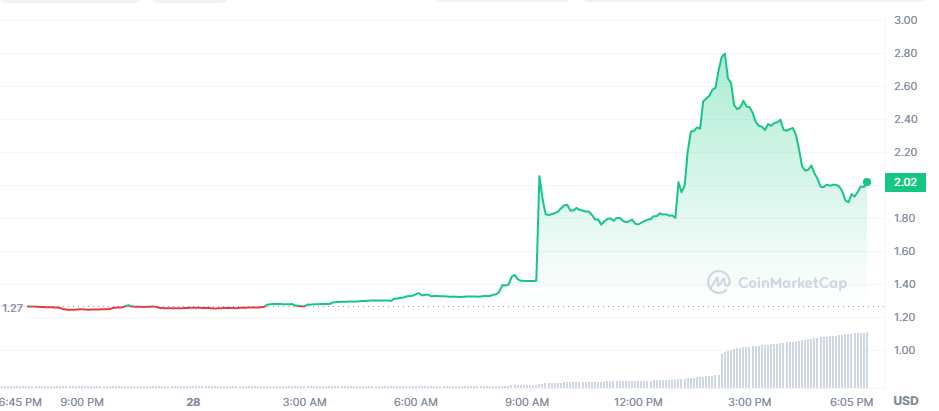LQTY, the sister token of lending protocol Liquity’s LUSD stablecoin, surged 103% to $2.78 amid a dramatic spike in trading volume after Binance announced that it would list the token in its Innovation Zone on March 1, 2023.
Trading volume for the token is up 3242% in the last 24 hours after Binance opened LQTY deposits and announced forthcoming support for the LQTY/BTC and LQTY/USDT spot pairs.
SponsoredLQTY Records Second Double-Digit Rally in February
The latest LQTY surge follows a rally of 35% earlier this month after the New York State Department of Financial Services ordered Paxos, the issuer of BUSD, a fiat-backed stablecoin, to stop minting the asset. NYSDFS ordered Paxos to sever ties with Binance, the world’s largest exchange whose branding BUSD carries. LQTY is the native token of Liquity, a decentralized lending protocol on the Ethereum blockchain.

The token’s rally marks a potential reversal in the market’s perception of the safety of algorithmic stablecoins like DAI and LQTY’s sister coin LUSD after the collapse of TerraUSD in 2022. Recent U.S. draft legislation on stablecoins only makes provision for those coins backed by fiat money, like USDT and USDC. These two popular stablecoins are issued by a centralized entity, making them prone to censorship and regulation, an area of growing importance for U.S. customers as regulators bring crypto into their crosshairs.
LUSD, on the other hand, relies on a decentralized mechanism to maintain its peg to the U.S. dollar. It holds a value of $1 through a unique redemption mechanism and an algorithm that adjusts Liquity’s loan issuance fees. Liquity issues LQTY to users who contribute to LUSD’s stability by depositing the stablecoin in a so-called Stability Pool.
LQTY holders can stake their tokens to earn rewards from revenue generated through Liquity’s loan issuance fee and redemption mechanism.
Since the NYSDFS order, the BUSD’s market cap has fallen about $6 billion to $10,570,597,480. Holders have also exchanged their BUSD for other stablecoins. Binance rival Coinbase yesterday announced that it would suspend BUSD trading on March 13, 2023.
SponsoredBinance CEO Battles FTX Comparison
In the meantime, Binance CEO battled allegations involving BUSD in a recent Forbes piece around the exchange’s handling of user assets.
In the piece, Forbes writers implied that assets in wallets backing user deposits were sent to other parties. To which the Binance CEO responded, “They seem to not understand the basics of how an exchange works. Our users are free to withdraw their assets any time they want. ” He also rejected comparisons to FTX, whose CEO is facing criminal charges for the alleged misappropriation of customer funds.
Chief Strategy Officer Patrick Hillman confirmed that the exchange maintains an internal ledger of user assets separate from wallet records. Forbes alleged that this dual bookkeeping strategy undermined efforts by the exchange to be more transparent. Notably, it did not mention how banks manage customer balances but still use their funds to generate high interest elsewhere.
In his defense of Binance, CZ did not address allegations that Binance liquidated USDC collateral to issue BUSD to inflate the asset’s market cap in August 2022. Questions surrounding the under-collateralization of customers’ USDC deposits on three separate occasions last year also went unanswered.
Binance mints BNB Chain versions of cryptocurrencies customers deposit for use in a single blockchain. It is supposed to hold assets backing these so-called B-Tokens in wallets that are separate from those holding customer funds. But it was recently found to have accidentally mixed the B-Token reserves with customer funds.
It recently announced that it would only mint new B-Tokens when the reserve wallets held sufficient collateral to back a deposit.
For Be[In]Crypto’s latest Bitcoin (BTC) analysis, click here.

